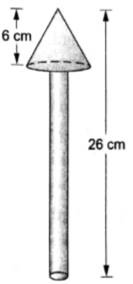A wooden toy is in the shape of a cone mounted on a cylinder, as shown in the figure. The total height of the toy is 26 cm, while the height of the conical part is 6 cm. The diameter of the base of the conical part is 5 cm and that of the cylindrical part in 4 cm. The conical part and the cylindrical part are respectively painted red and white. Find the area to be painted by each of them colours. [Take π = 22/7.]

The wooden toy is in the shape of a cone mounted on a cylinder
Total height of the toy = 26 cm
Height of conical part = H = 6 cm
Height of cylindrical part = Total height of the toy – Height of conical part
h = 26 cm – 6 cm = 20 cm
Diameter of conical part = 5 cm
Radius of conical part = R = Diameter/2 = 5/2 cm = 2.5 cm
Let L be the slant height of the cone
L2 = H2 + R2
⇒ L2 = 62 + 2.52 cm2 = 36 + 6.25 cm2 = 42.25 cm2
⇒ L = 6.5 cm
Diameter of cylindrical part = 4 cm
Radius of cylindrical part = r = Diameter/2 = 4/2 cm = 2 cm
Area to be painted Red = Curved Surface area of cone + Base area of cone – base area of cylinder
Area to be painted Red = πRL + πR2 – πr2 = π (RL + R2 – r2)
= 22/7 × (2.5 × 6.5 + 2.5 × 2.5 – 2 × 2) cm2
= 22/7 × (16.25 + 6.25 – 4) cm2
= 22/7 × 18.5 cm2
= 58.143 cm2
Area to be painted White = Curved Surface area of cylinder + Base area of cylinder
Area to be painted White = 2πrh + πr2 = πr (2h + r)
= 22/7 × 2 × (2 × 20 + 2) cm2
= 22/7 × 2 × (40 + 2) cm2
= 22/7 × 2 × 42 cm2 = 264 cm2
∴ Area to be painted red is 58.143 cm2 and area to be painted white is 264 cm2.